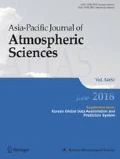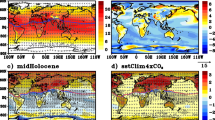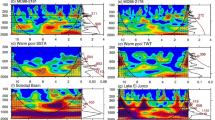Abstract
The western North Pacific subtropical high (WNPSH) is a crucial component of the East Asian summer monsoon (EASM) system and significantly influences the precipitation in East Asia. In this study, distinguished role of WNPSH on the EASM and Indian Ocean monsoon (IOM) are investigated. Based on the boreal summer mean field of 850-hPa geopotential height and its interannual variability, the WNPSH index (WNPSHI) is defined by the areaaveraged geopotential height over the region [110°–150°E, 15°–30°N]. The WNPSHI is significantly related to the precipitation over the East Asian monsoon (EAM) region [105°–150°E, 30°–40°N] and IOM region [70°–105°E, 5°–15°N]. Rainfalls over these two regions have good correlation with WNPSH developments and the geopotential height fields at 850 hPa related to the EAM precipitation and IOM precipitation have remarkably different teleconnection patterns in boreal summer. These features exhibit that EAM and IOM precipitations have different type of development processes associated with different type of WNPSH each other. Focusing on the relationships among the EAM precipitation, IOM precipitation, and the WNPSH variabilities, we assume that WNPSH and EAM precipitation are usually fluctuated simultaneously through the sea surface temperature (SST)-subtropical ridge-monsoon rainfall feedback, whereas the IOM precipitation varies through the different process. To clarify the relationships among WNPSH, EAM, and IOM, two cases are selected. The first one is the case that all of WNPSH, EAM, and IOM are in phase (WE(+)I(+)), and the second one is the case that WNPSH and EAM are in phase and WNPSH/EAM and IOM is out of phase (WE(+)I(−)). These two cases are connected to the thermal forcing associated with SST anomalies over the eastern Pacific and Indian Ocean. This different thermal forcing induces the change in circulation fields, and then anomalous circulation fields influence the moisture convergence over Asian monsoon regions interactively. Therefore, the monsoon rainfall may be changed according to the thermal conditions over the tropics.
Similar content being viewed by others
References
Chang, C.-P., Y. Zhang, and T. Li, 2000a: Interannual and interdecadal variations of the East Asian summer monsoon and tropical Pacific SSTs. Part I: Roles of the subtropical ridge. J. Climate, 13, 4310–4325.
____, _____, and _____, 2000b: Interannual and interdecadal variations of the East Asian summer monsoon and tropical Pacific SSTs. Part II: Meridional structure of the monsoon. J. Climate, 13, 4326–4340.
Ha, K.-J., and S.-S. Lee, 2007: On the interannual variability of the Bonin High associated with the East Asian summer monsoon rain. Climate Dyn., 28, 67–83, doi:10.1007/s00382-006-0169-x.
Huang, R., and F. Sun, 1992: Impacts of the tropical western Pacific on the East Asia summer monsoon. J. Meteor. Soc. Japan, 70, 243–256.
Kanamitsu, M., W. Ebisuzake, J. Woolen, S.-K. Yang, J. J. Hnilo, M. Fiorino, and G. L. Potter, 2002: NCEP-DOE AMIP-II reanalysis (R-2): Dynamical seasonal forecast system 2000. Bull. Amer. Meteor. Soc., 83, 1631–1643.
Kim, J.-E., S.-W. Yeh, and S.-Y. Hong, 2009: Two types of strong northeast Asian summer monsoon. J. Climate, 22, 4406–4417.
Lee, E.-J., J.-G. Jhun, and C.-K. Park, 2005: Remote connections of the northeast Asian summer rainfall variation revealed by a newly defined monsoon index. J. Climate, 15, 3252–3265.
____, S.-W. Yeh, J.-G. Jhun, and B.-K. Moon, 2006: Seasonal change in anomalous WNPSH associated with the strong East Asian summer monsoon. Geophys. Res. Lett., 33, L21702, doi:10.1029/2006GL027474.
Li, S., J. Lu, G. Huang, and K. Hu, 2008: Tropical Indian Ocean basin warming and East Asian summer monsoon: A multiple AGCM study. J. Climate, 21, 6080–6088.
Liu, Y., and G. Wu, 2004: Progress in the study on the formation of the summertime subtropical anticyclone. Adv. Atmos. Sci., 21, 322–342.
Lu, R., 2001: Interannual variability of the summertime North Pacific subtropical high and its relation to atmospheric convection over the Warm Pool. J. Meteor. Soc. Japan, 79, 771–783.
____, and B. Dong, 2001: Western extension of North Pacific subtropical high in summer. J. Meteor. Soc. Japan, 79, 1229–1241.
____, 2004: Associations among the components of the East Asian summer monsoon system in the meridional direction. J. Meteor. Soc. Japan, 82, 155–165.
____, and Z. Lin, 2009: Role of subtropical precipitation anomalies in maintaining the summertime meridional teleconnection over the western North Pacific and East Asia. J. Climate, 22, 2058–2072.
Ninomiya, K., and C. Kobayashi, 1999: Precipitation and moisture balance of the Asian summer monsoon in 1991. Part II: Moisture transport and moisture balance. J. Meteor. Soc. Japan, 77, 77–99.
Nitta, T., 1987: Convective activities in the tropical western Pacific and their impact on the Northern Hemisphere summer circulation. J. Meteor. Soc. Japan, 65, 373–390.
Park, J.-Y., J.-G. Jhun, S.-Y. Yim, and W.-M. Kim, 2010: Decadal changes in two types of the western North Pacific subtropical high in boreal summer associated with Asian summer monsoon/El Niño-Southern Oscillation connections. J. Geophys. Res., 115, D21129, doi:10.1029/2009JD013642.
Rayner, N. A., D. E. Parker, E. B. Horton, C. K. Folland, L. V. Alexander, D. P. Rowell, E. C. Kent, and A. Kaplan, 2003: Global analyses of sea surface temperature, sea ice, and night marine air temperature since the late nineteenth century. J. Geophys. Res., 108, D14, 10.1029/2002JD-002670.
Rodwell, W. R., and B. J. Hoskins, 2001: Subtropical anticyclones and monsoons. J. Climate, 14, 3192–3211.
Sui, C.-H., P.-H. Chung, and T. Li, 2007: Interannual and interdecadal variability of the summertime western North Pacific subtropical high. Geophys. Res. Lett., 34, L11701, doi:10.1029/2006GL029204.
Wang, B., R. Wu, and X. Fu, 2000: Pacific-East Asia teleconnection: How does ENSO affect East Asian climate? J. Climate, 13, 1517–1536.
Wu, R., G. and B. Wang, 2000: Interannual variability of summer monsoon onset over the western North Pacific and the underlying processes. J. Climate, 13, 2483–2501.
Xie, P., and P. A. Arkin, 1997: Global precipitation: A 17-year monthly analysis based on gauge observations, satellite-estimates, and numerical model outputs. Bull. Amer. Meteor. Soc., 78, 2539–2558.
Xie, S.-P., K. Hu, J. Hafner, H. Tokinaga, Y. Du, G. Huang, and T. Sampe, 2009: Indian Ocean capacitor effect on Indo-western Pacific climate during the summer following El Nino. J. Climate, 22, 730–747.
Yim, S.-Y., S.-W. Yeh, R. Wu, and J.-G. Jhun, 2008: The influence of ENSO on decadal variations in the relationship between the East Asian and western North Pacific summer monsoon. J. Climate, 21, 3165–3179.
Yun, K.-S., K.-H. Seo, and K.-J. Ha, 2008: Relationship between ENSO and northward propagating intraseasonal oscillation in the east Asian summer monsoon system. J. Geophys. Res., 113, D14120, doi:10.1029/2008JD009901.
____, _____, and _____, 2010: Interdecadal change in the relationship between ENSO and the intraseasonal oscillation in East Asia. J. Climate, 23, 3599–3612.
Zhou, T., and R. Yu, 2005: Atmospheric water vapor transport associated with typical anomalous summer rainfall patterns in China. J. Geophys. Res., 110, D08104, doi:10.1029/2004JD005413.
____, _____, J. Zhang, H. Drange, C. Cassou, C. Deser, D. L. R. Hodson, E. Sanchez-Gomez, J. Li, N. Keenlyside, X. Xin, and Y. Okumura, 2009: Why the western Pacific subtropical high has extended westward since the late 1970s. J. Climate, 22, 2199–2215.
Author information
Authors and Affiliations
Corresponding author
Rights and permissions
About this article
Cite this article
Lee, SS., Seo, YW., Ha, KJ. et al. Impact of the western North Pacific subtropical high on the East Asian monsoon precipitation and the Indian Ocean precipitation in the boreal summertime. Asia-Pacific J Atmos Sci 49, 171–182 (2013). https://doi.org/10.1007/s13143-013-0018-x
Received:
Revised:
Accepted:
Published:
Issue Date:
DOI: https://doi.org/10.1007/s13143-013-0018-x




